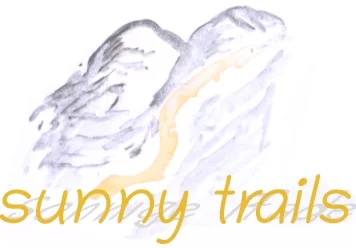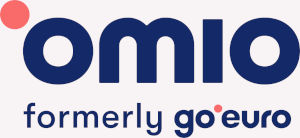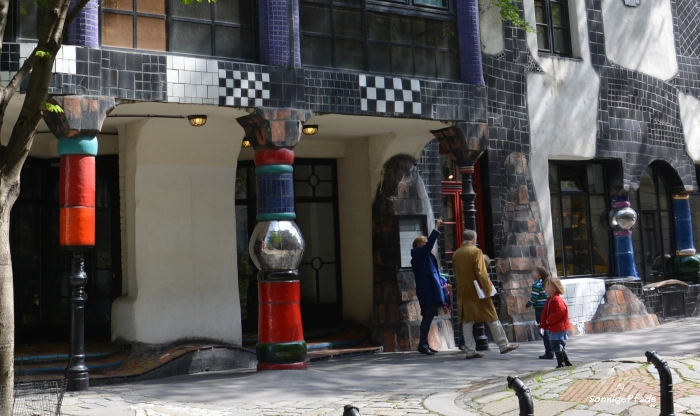
A foray through Hundertwasser’s unique painting, architecture and art
Everyone knows that the European city Vienna in Austria is worth a visit. For most, the „Viennese Classicism“ is the main incentive to travel to the Austrian capital. However, the focus here will be on a different era and a special artist of the 20th century – Friedensreich Hundertwasser. His extensive creative period stretched from the 1950s to the early 2000s and included, in addition to his distinctive painting, many examples of idiosyncratic architecture as well as interference in social and environmental issues.
Throughout his life, Hundertwasser was a contentious contemporary who often fundamentally questioned common ways of thinking. For a long time Friedensreich Hundertwasser’s artistic expression developed in painting, graphics and printmaking. Later, many of his ideas were „firmly built“ into Hundertwasser’s architectural projects. Vienna, the city of his birth, remained the artist’s main place of work, along with many other places around the globe, and today boasts several much-visited Hundertwasser buildings as well as the most important art collection.
Which buildings of the Hundertwasser – architecture can be discovered in Vienna?
The Hundertwasser house and Hundertwasser village
The best known is probably the Hundertwasser House Vienna in the Löwengasse/ corner to Kegelgasse. This house was built completely new according to the plans of Friedensreich Hundertwasser as social housing of the municipality of Vienna. In the house are „normal“ apartments for tenants. These have to cope with streams of tourists, because the Hundertwasser – house is marveled at all year round by many Vienna – visitors. However, only from the outside. Access to the private rooms of the residents is of course not possible.
But directly opposite there is an information point to the Hundertwasser house in the same style – the Hundertwasser Village in Vienna. With bar, bookstore, public toilets, souvenir store and an impression of how interiors were designed by Friedensreich Hundertwasser. Admission to the Hundertwasser Village is free.
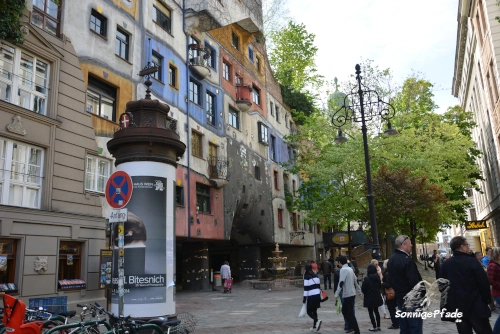
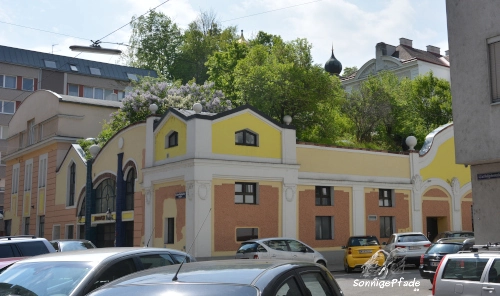
Kunsthaus Vienna – Museum and Gallery for Hundertwasser – Artwork
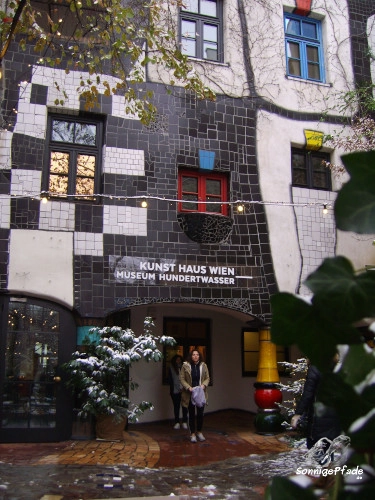
Not far from the Hundertwasser House and Village, at Untere Weißgerber street 13, within walking distance, you will find the Kunsthaus Vienna (Art house), the painting and art museum for the multifaceted oeuvre of Friedensreich Hundertwasser. Anyone who is enthusiastic about his painting and architecture should definitely visit it. Because here you get a comprehensive overview in the exhibition over several floors with works of Friedensreich Hundertwasser – from his paintings to the stamps designed by him to flag – proposals, etc.. Also models of architecture – designs and many impulses from his ecological engagement you will find at this place. The Kunsthaus Wien was redesigned by Hundertwasser. Already on the way from the Hundertwasserhaus to the Kunsthaus Wien you will pass another facade redesigned by Hundertwasser at Untere Weißgerberstraße 31.
The café, store and courtyard space in the Kunsthaus Wien are free of charge, an entrance fee is charged for the exhibition rooms.
Vienna Spittelau heating plant
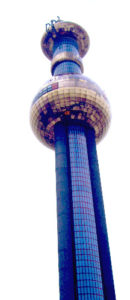
If you are already in Vienna and interested in Hundertwasser’s buildings, you should not shy away from the way to Spittelau. In this part of the city, an old thermal power plant was redesigned by Hundertwasser. This also includes the office building of Fernwärme Wien (Remote heating company Vienna). A walk around a heating plant is already unusual – who else looks at an industrial – plant? But this is exactly what is intended. Hundertwasser wanted and was able to ‘give a face‘ to the somewhat neglected district with his design. In addition, he connected with his work the demand for the highest technical standards for the waste incineration plant.
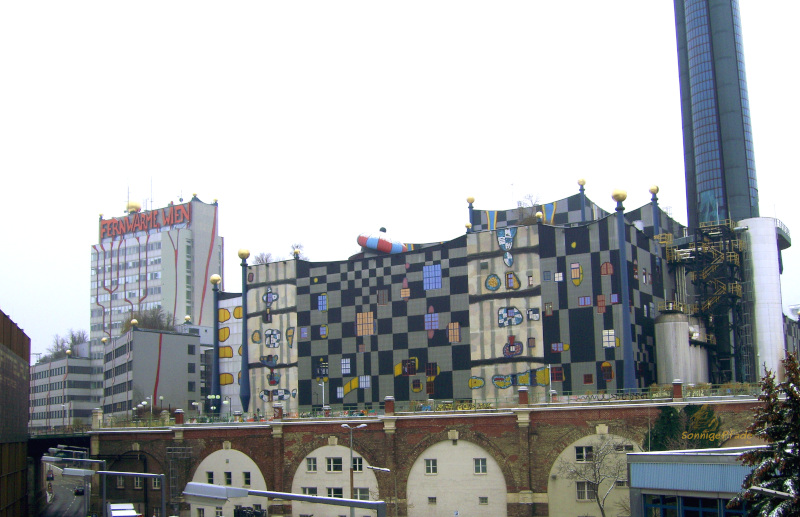
Who was this Friedensreich Hundertwasser?
The childhood and youth of Friedrich Stowasser
Friedrich Stowasser was born on December 15, 1928 in Vienna. Already one year after his birth his father died, so that he grew up in a single-parent household with his mother. As an employee of a bank, she managed to survive on a small income. But there were no riches. Little Stowasser was enrolled in a Montessori school. The report of the first grade certified an extraordinary understanding for colors and forms. For the mother this was rather a reason to take the boy out of this school. He should learn the ‚important things‘ for life, such as reading and arithmetic, thoroughly. A solid education that promised a future without hardship.
But the much time spent alone at home, while his mother was at work, not only caused an inner withdrawal, but also an intense preoccupation with painting. Thus, by the end of his school years, he was already able to produce sketches and paintings with gifted painting technique and strong expression. His path then also led to the art academy rather than to a technical college.
Hundertwasser as a young painter
In 1948 Hundertwasser visited an exhibition of paintings by Egon Schiele, which impressed him very much. Especially the vivid depiction of the walls of houses apparently has a long lasting effect on him and inspires him to the definition of the „third skin“ of man, the houses.
Hundertwasser spends the winter of 1949/ 50 in Paris. He lives under the simplest conditions in the studio with patrons who have become aware of his work and want to promote the young artist. There he also changes his last name. The syllable „sto“ means „hundred“ in Slavic languages, so that since that time he calls himself „Hundertwasser“. That the old name Stowasser probably has its roots more in the German transliteration of Stauwasser (Damming water), he learns only later. And it is not important to him. In 1949, on a trip to Italy, he discovers ceramic tiles as wall coverings in an old Roman café. The ‚melting colors‚ remain deep in his memory – he will later work a lot with ceramics and tile mosaics.
More and more he criticizes ‚the straight line that makes people sick‚ in the architecture of the time. And more and more often he declares himself against what, as a characteristic of rationalism, has taken hold as a recurring continuum since the twenties. Hundertwasser received his imprint from the rounded rather organic forms of the Viennese Baroque and Art Nouveau. His models are Antonio Gaudi with his buildings in Barcelona or the towers of Simon Rodias in Los Angeles. From 1953 a new element enters his painting: the spiral. Spirals of color practically become more and more the trademark of his works.
International recognition as an artist
At the beginning of the 1960s, Hundertwasser spent a year in Japan. There he changes his first name in 1961, so that Friedrich Hundertwasser becomes Friedensreich via Friederich. Under the name „Friedensreich Hundertwasser“ (engl meaning: Peaceful Hundredwater) he reaches worldwide fame.
Only in his home country Austria it took a long time with the recognition. When he reached a certain renown internationally only, exhibited in Venice, Paris and New York, the popularity in Vienna grew. In the meantime, he became increasingly involved in the artistic-political debate. He was more and more concerned with ecological themes and social issues. A series of manifestos from his pen are available, which he disseminated in the art scene and the public.
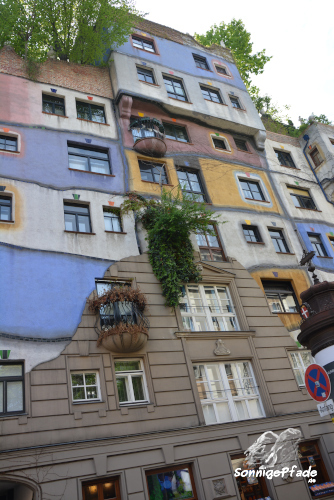
In 1967 Friedensreich Hundertwasser held a first „naked speech“ for the right to the 3rd skin. Apartments, houses should enclose people like a skin – that is, be an organic shell rather than a stone construction from the drawing board with straight lines and right angles.
Further naked speeches repeatedly oppose „rationalism in architecture“. Later, he also declares a „window right“ for tenants, who should have the right to freely design up to arm’s length around the windows for their living space. To bring this idea to the world, Hundertwasser produces 10,000 prints of the painting „Good morning city – bleeding town“ in several variations. For this purpose, he also develops new printing techniques involving metal foils. Connected with the „window right“ for the tenants is the „tree duty“ – houses should also give space to trees, both around the trees and on balconies, from open windows and on the roof, trees and green plants should grow and be cared for by the residents. As early as 1973, Friedensreich Hundertwasser drew attention to this concept with a „Tree Tenant Action“ at the Triennale di Milano.
Hundertwasser’s way into an ecological commitment
Travels bring Hundertwasser around the world. Not only in the context of exhibitions or art projects. He chooses his destinations himself and goes there. The visit to Africa has a strong influence on his painting – colors become more earthy, forms rounder and more organic. With his own ship „Regentag“ (rainy day), a 12-tonner converted into a two-master, he goes to New Zealand. There he buys a remote plot of land and spends a lot of time in this region.
Water, humus, material cycles… these are topics that increasingly occupy him. He does not want to burden the earth, he wants to heal. In addition to his artistic manifesto „The Holy Shit“, Hundertwasser propagates the humus toilet, men as a humus-producing organism. That is consistent and provocative. And yet necessary. An organism, which meanwhile covers the earth with 7 billion individual issues, has side effects. Especially if it tries to place itself above the natural cycles or interrupts them. The global environment, the ecological environment of man is the fifth skin for the artist.
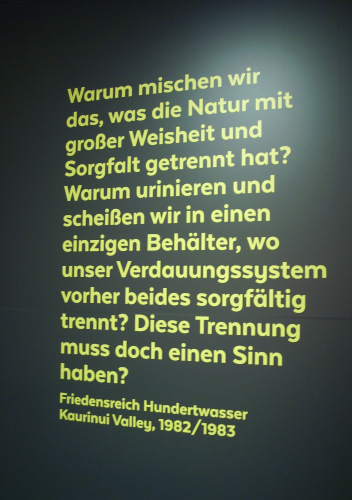
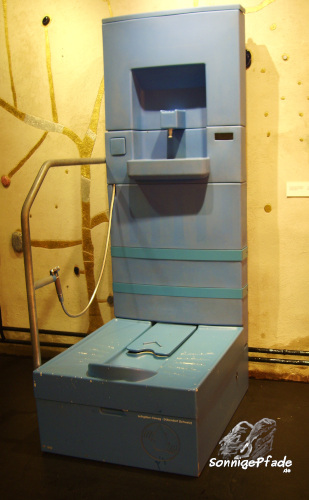
In the seventies, Friedensreich Hundertwasser’s artistic field of work expands. In addition to „classical“ painting, work on graphics is added. He develops printing techniques further, where he can incorporate metal foils into the prints and produces limited editions of print graphics, each of which is unique in detail due to small changes. Several times he designs stamp series. In 1975, the Austrian Post Office commissions him for the first time to produce a series on „Modern Art in Austria“. The Senegalese president turns to Hundertwasser in 1979 with the request for a stamp series. Liechtenstein, Switzerland, the United Nations and Cape Verde follow. Several of the stamps receive prizes.
With flag designs Friedensreich Hundertwasser tries to live up to his name as peacemaker. Thus, flag proposals are created as a Koru flag for New Zealand for reconciliation with the Maori aborigines, Uluru flag for Australia or also a peace flag for the Promised Land, for Israel in the peace process with the Palestinians.
In addition, he is increasingly creating models of buildings that, in his opinion, can combine high living quality, ecological quality and artistic standards.
Friedensreich Hundertwasser – Engaged as an ecological activist and „Architecture – Doctor“
The Hundertwasser House is built in Vienna
At the beginning of the 80s Friedensreich Hundertwasser intensified his activities to develop practical architecture – alternatives. Until then he was more the critic. Now he creates his counter-design. After Hundertwasser had gone public in the seventies with many models for nature-oriented and community-promoting buildings, his ideas were now finally to become reality. In 1980 he presented his model for a house with social housing in Vienna to the city council. And the city votes in favor of the construction. Since the independent architects do not want to support the „career changer“, the Vienna municipality commissions one of its salaried architects with the building plans in collaboration with Hundertwasser.
What emerges is a small village, in the middle of Vienna. Each apartment in the Hundertwasser House has its own characteristics, its own colors, friendly design and plenty of atmosphere for the residents. This includes lots of greenery – green roofs and terraces, „tree tenants“ with their own „apartments“, extra – stairs to access the green areas…. Alone 13 different window formats are installed. A new element finds its way into Hundertwasser’s architecture – the onion design. „The onion shape stands for wealth and happiness, for prosperity and abundance, and for fertility“ he says. The building craftsmen face challenges – but also take center stage. Rarely do builders experience so much appreciation and encouragement for their work.
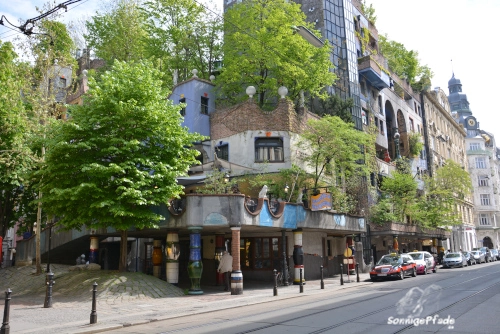
Hundertwasser himself is often on site, helping out, designing together with the bricklayers and tilers. In order not to let the costs grow out of control, many standard parts from industrial mass production and from the catalogs of the local hardware dealers are used. Just creatively combined and „colorfully distributed“. Each apartment is different, more individual.
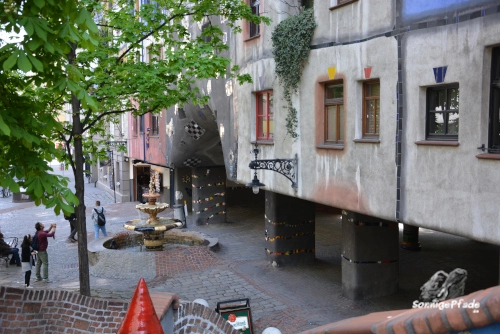
When the city of Vienna invites to an „open day“ in the Hundertwasser house in September 1985, before the house is occupied, 70,000 Viennese come to see this new landmark of the city. In the meantime, the Hundertwasser house has become one of Vienna’s most famous sights.
Active promoter of the environmental protection movement
Many other projects run parallel. Especially in the 80s Friedensreich Hundertwasser designs posters for the environmental movement – for the free sea without pollution, for whales, for environmental preservation in general, for individual actions and against nuclear power. „More green in Vienna“ is as important to him as saving an old lime tree or the resistance against a Danube – power plant, to which the forest near Hainburg is to be sacrificed. To save the floodplain near Hainburg, Hundertwasser even camped out with the environmental activists in the forest for a week in the winter snow.
In parallel, a number of other architectural projects are already developing. The church Santa Barbara in Bärnbach is an unadorned post-war building and is to be extensively renovated. Friedensreich Hundertwasser is hired for the design and puts a golden onion crown on the old tower. The entire church building receives a „Hundertwasser – imprint“ and in the church garden a park is created for the reconciliation of the religions of the earth. A sober church building from the post-war period becomes a colorful, lively temple of peace and happiness. This corresponds to his claim as an „architecture – doctor“, who wants to eliminate the shortcomings of soulless buildings and create friendly spaces for people and the environment in the sense of the 5 skins.
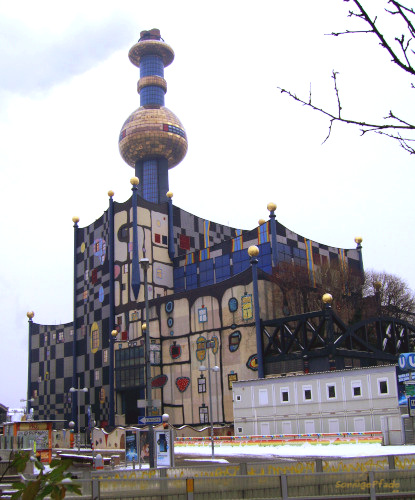
Drawings and models now follow at short intervals. Again the city of Vienna commissions Hundertwasser with a modernization in 1988. With the redesign of the waste incineration plant in Vienna Spittelau, a heating power plant in the north of Vienna, Hundertwasser is heavily criticized. This time rather from friends in the ecology movement. He himself wrestles with this task for over a year. At the end it is clear for him – the garbage incineration with most modern filters is at the moment the best possible alternative in handling the resulting garbage of the large city Vienna. But there is no way around eliminating the word „garbage“ for the future and reintegrating people into the organic cycle systems of nature.
Architecture of Hundertwasser in the whole German-speaking area
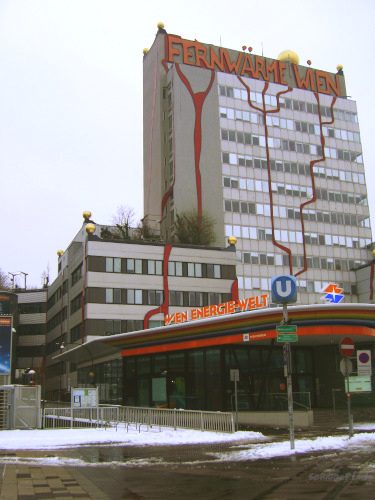
Also in the 90s more and more of the architecture – projects are planned and implemented. Meanwhile everywhere in the German-speaking area, partly even beyond. Whether a highway – service area in Bad Fischau (Lower Austria), the reconstructed train station in Uelzen, a residential complex in Bad Soden in Taunus (both West germany) or a thermal village in Blumau in Styria – small and large projects, conversions and new facilities are created. Since 1990, then, also in East Germany: A large-scale project – the „Grüne Zitadelle“ (Green citadel) – in Magdeburg revitalizes the war-destroyed and somewhat unhappily rebuilt city on the Elbe river.
The „Green Citadel“ is the last completely rebuilt Hundertwasser building. There in Magdeburg, by the way, one has corrected a „beginner’s mistake“ – even though large areas of the Hundertwasser House are private and not accessible, there are more public areas and within the framework of the frequent guided tours, anyone interested can take a look inside a Hundertwasser House. Including the ascent to the tower with a view from above on the green roofs and terraces of this Hundertwasser building.
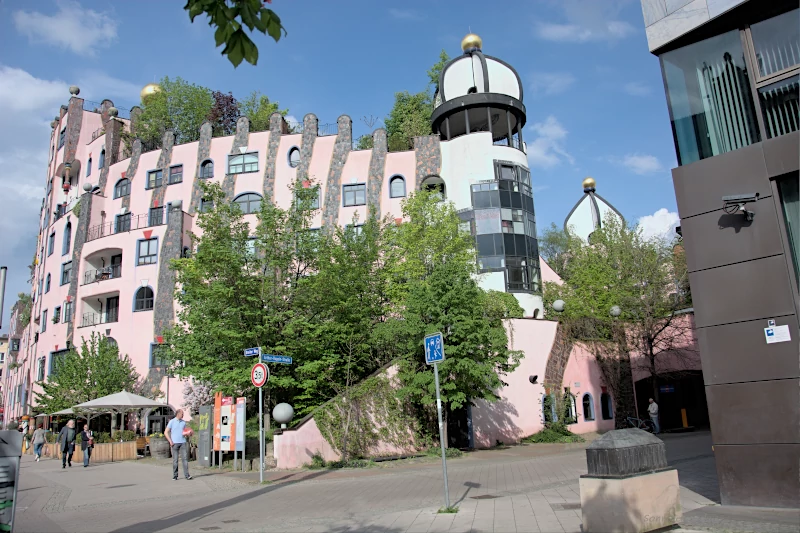
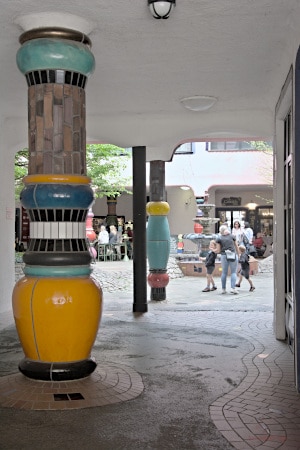
the inner courtyard
Only a few kilometers upstream in Wittenberg, a GDR prefabricated concrete slab school becomes the Martin Luther High School. In Switzerland, the cheerful Altenrhein market hall, crowned with golden hoods, is being built.
An end in the midst of success – Hundertwasser’s death after the turn of the millennium
Actually still full of energy and with many projects planned and in progress, Friedensreich Hundertwasser dies on January 19, 2000 on board the passenger ship Queen Elizabeth 2 off Brisbane, Australia. He was on his way back to Europe from his adopted home in New Zealand. His gravesite is in the Kaurinui Valley in New Zealand.
Unfortunately many ideas and plans are not realized anymore. However, the interest in his works is unbroken, Hundertwasser – buildings are everywhere pilgrimage places of his followers as well as of people who want to be inspired by the unconventional, lively, colorful houses. So especially in his birthplace Vienna.
Other buildings by Hundertwasser in the vicinity of the Hundertwasser House in Vienna
Hundertwasser Village
At the Hundertwasser House in Vienna, the artist continued to seek dialogue with the neighbors. Through this at the end of the eighties he got in touch with the tire dealer Kalke, who ran a garage across the street in a former stable for post office horses. From him Hundertwasser learned that the transactions for the sale of tires were suffering from the ever-increasing number of visitors to the Hundertwasser House.
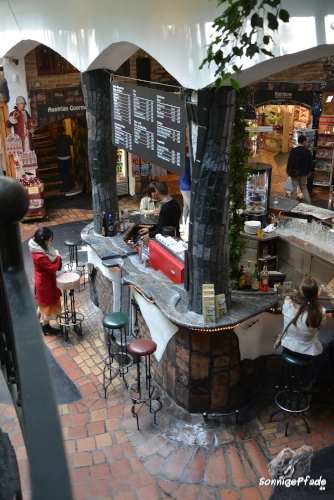
The mass of curious people is also for the residents of the house in Löwengasse the only shortcoming that is always complained about. And the tourists regret that they cannot visit the Hundertwasser House inside. Kalke, who despite everything is very open-minded about Hundertwasser’s architecture, agrees to convert part of his garage into a visitor center for the Hundertwasser House. In the end, the two, now friends, convert the entire building into the Hundertwasser Village – with a bookstore, souvenir store, restaurant and visitor toilets. There the guests, who got an external impression of the Hundertwasser House, can now also look at interiors in the Hundertwasser style and comfortably spend some time in the café. The visit to the Hundertwasser Village is free of charge.
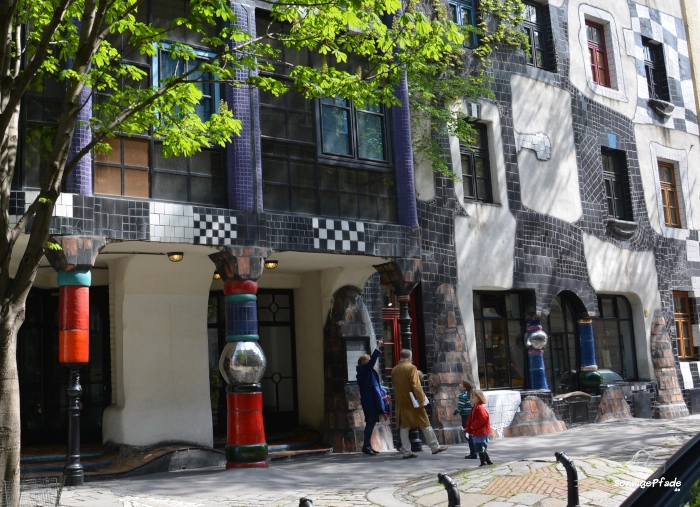
The Kunsthaus Wien – Museum for Hundertwasser art and painting
Nearby, in the Untere Weißgerberstraße Nr.13 another house was rebuilt by Hundertwasser – the Kunsthaus (art-house) Vienna. This exhibition house previously housed a furniture factory and is primarily to be seen as a gallery-museum for Friedensreich Hundertwasser. Works by the painter and graphic artist are exhibited over two floors, along with some of the architectural models, stamp sets, flag designs and other products of his work. Two other floors are reserved for temporary exhibitions of other artists. On the ground floor, in addition to the museum ticket office and a small store, a café awaits visitors. In the courtyard of the Kunsthaus Wien, further details from Hundertwasser’s collection of ecological ideas can be found in side buildings – for example, a model of a public toilet house with an attached vertical plant sewage treatment plant. A large functional model of this sewage purification system ensures a good climate in the room.
In the warm season, the courtyard also attracts visitors with outdoor seating under trees. The entrance fee for the exhibition at the Kunsthaus Wien is about 12€ for adults. Audio-guides in several languages can be rented. The Kunsthaus Wien is open daily from 8 am to 6 pm.
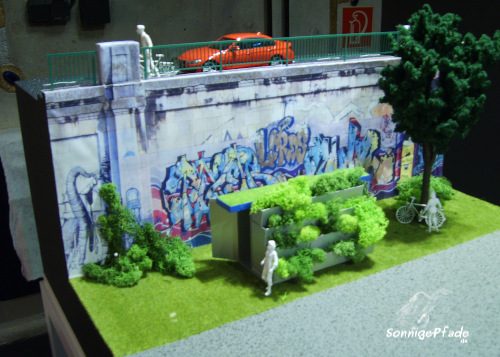
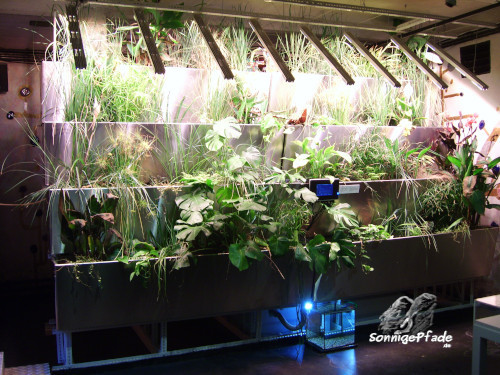
Travel tips for Vienna
Whether as part of a longer stay in Austria or Slovakia or nearby Hungary, or especially for an extensive visit to Vienna, the city is worth at least one trip. For a long time, Vienna was the capital of the vast Habsburg kingdom and held a key position in linking East and West, Franco-Germanic cultures in the West and Slavic cultures in the East. The centers of power left their mark on the architecture, especially in the „Austrian Baroque“. For this reason alone, a visit to this city is worthwhile. But also, if you want to learn more about the artist Friedensreich Hundertwasser, you should not just plan one day for Vienna. The Kunsthaus Wien and the Hundertwasser buildings alone offer enough potential for a day’s visit.
[Contains *advertising]
Journey to Vienna in Austria
By plane to Vienna
Vienna is very easy to reach by plane. Vienna’s Schwechat Airport, located south of the city, is a hub for many intercontinental flights. From the US east coast you can search for a good flight with Condor* and partners via Frankfurt am Main, with Iberia* via Madrid or with brussels air*.
Therefore, it is also served by smaller aircraft from many other airports in Europe, which transfer long-distance fliers as feeders to Vienna. So you can get to Vienna from practically anywhere in Europe in a short time. For instance, the low cost airline easyjet* is on service between UK and other European airports and the Vienna airport.
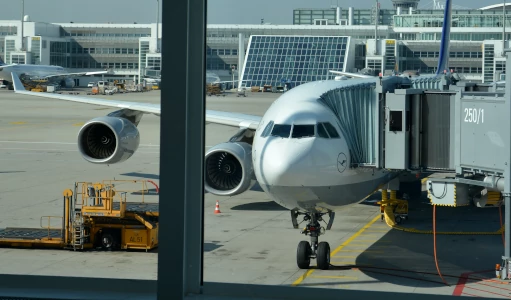
From and to the airport Wien-Schwechat there is a railroad – airport shuttle to the underground – station Wien – Mitte. It goes directly to the center without many stops in between. However, it is relatively expensive. It is only a little slower, but much cheaper to take the normal S-Bahn train to the center of Vienna. You can use a city-ticket with an additional link ticket. For more information, see Local Transport in Vienna.
To Vienna by train and long-distance bus
Vienna is very easy to reach by train. This is perfectly possible from western and central Europe, e.g. Frankfurt am Main airport.
Austrian Railways (ÖBB) runs am expanding wide range night train service. Thus, it is also very well possible from many cities in western Europe to take an ÖBB night train to Vienna. It is recommended to select and book them via omio*. If you travel in a couchette or sleeping car, you save the first night’s accommodation and can get started in Vienna right from the morning.
By long-distance bus with Flixbus or comfortably with RegioJet via the Czech Republic
Vienna is also integrated into the european long-distance bus network. In the meantime, Flixbus* has largely established itself as a quasi-monopolist in central Europa. The inexpensive journey by long-distance bus is possible from many European cities, especially since many lines offer Vienna as a terminus over long distances. However, the journey to Vienna takes a relatively long time. Here, too, an overnight trip is a good option in order to have to plan fewer overnight stays on site.
An alternative to Flixbus is the Czech-Slovakian long-distance bus and train provider RegioJet*. This company, originally founded as a student travel agency, operates several routes from western Europe through Germany to Prague, from where one route continues to Vienna and to Venice in Italy. The advantage of RegioJet is greater comfort – on the bus, stewardesses take care of travelers, inform them about connections and serve them with hot and cold drinks and small snacks at their seats. Since they keep an eye on their guests and count them after the stop, it is unlikely that a passenger will be forgotten at a rest stop.
By car, rental car or camper van to Vienna
Of course you can also get into your own car or take a rental car* or camper van*. Vienna is well connected to the european highway network. Only from the northeast via the Czech Republic there is no continuous highway connection (or only with a detour). In the south of the Czech Republic, country roads have to be used for a few kilometers.
In Vienna itself, I would leave the car somewhere on the outskirts or at the accommodation if possible. The public transport is simply so well developed and reasonably priced that it is not worthwhile to drive and look for a parking place yourself.
Mobility in Vienna – the local transport
Vienna has a very good public transport network with dense intervals and accessibility to relatively remote areas of the city. As already mentioned above, I would not go in search of a parking space in the center with my own car. Trams serve the center and the most important sights in close succession and bring passengers to the quarters via main lines. Suburban trains take over the fast change over several quarters. And especially further out, there are city buses, with which even the last corner can be reached quite easily.
… best with (multi-) day ticket
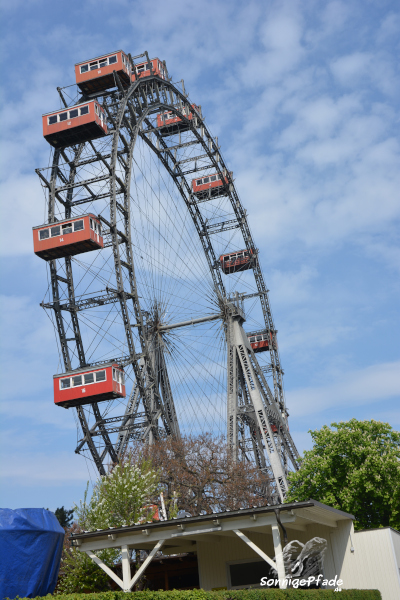
Depending on the length of your stay, day or multi-day tickets for the inner city zone are worthwhile. This includes most of the sights that tourists commonly visit in Vienna. And also to a large extent the accommodations of the guests. The tickets are valid for 24, 48, 72… hours, depending on the selected scope. The longer the period of validity, the cheaper they are per day. And quite affordable. If you don’t have a place to stay where everything you want to see is right around you anyway, you should definitely use the (multi-)day Vienna City ticket. The ticket you can buy easily at the ticket machine. You should consider beforehand exactly for how many days or hours. At the vending machine you can pay with Euro cash or credit card.
An additional link – ticket extends the mobility
If you want to reach a destination that goes beyond the city zone of Vienna, there are additional connecting tickets to the day ticket to buy. These are also quite cheap and are valid for a limited time after validation in conjunction with the main ticket. So you can use e.g. from/to the airport Vienna Schwechat your multi-day city ticket, to which you buy a additional link ticket. There are available certainly also at the vending machine. However, I prefer to buy them at the service counter of the Vienna Transport Authority. This gives me the security of holding the right card or card combination in my hand.
By public transport to the Hundertwasser House in Vienna
The Hundertwasser House is easy to reach by public transport. The suburban station Wien Mitte/ Landstraße, where the airport shuttle also ends, is very close. From there you can walk in 10min. The tram goes through Löwengasse past the Hundertwasserhaus, the closest stop is Hetzgasse.
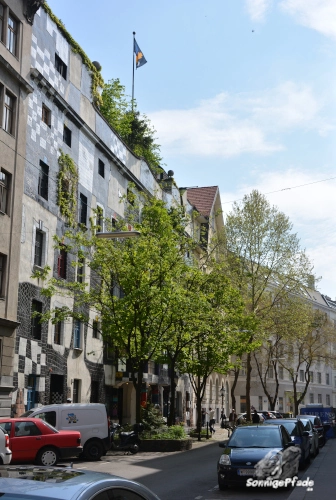
The Hundertwasser Village is right across from the Hundertwasser House. So only a few steps across the Kegelgasse.
And, if you follow the Hundertwasser Village in its long direction into Kegelgasse, you will come to Untere Weißgerberstraße. There to the left or north, there are 750m to the Kunsthaus Vienna, the Hundertwasser – Museum.
The waste incineration plant Spittelau is located near the Spittelau train station. This is also not far from Franz-Josefs-Station. It is best to take the streetcar to the Liechtenwerder Platz stop and then turn right on foot in the direction of the Nordberg bridge. In the large bend to the right, there is a path off to the left that leads to the heating plant. You can’t miss it, so don’t worry 🙂 You can walk around quite well on various footpaths. But the best photo spots are from the bank and the bridges on the Danube Canal, and especially in the evening at the „Blue Hour“.
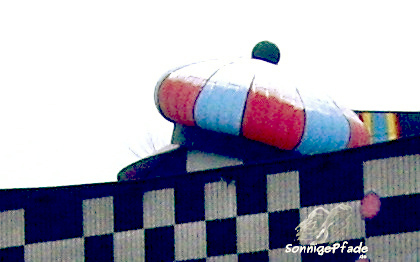
Accommodation in Vienna – hotels and apartments near the Hundertwasser House
Vienna, as the Austrian capital and tourist magnet, naturally has plenty of accommodations to offer. Here is a small selection near Hundertwasser house, Hundertwasser Village and Kunsthaus Wien art center, starting with the closest hotel (distances ascending):
The Ruby Sofie Hotel* in Vienna is closest to the Hundertwasser house, but also to the important traffic junction Wien – Mitte/ Landstraße. So getting there is not a problem at all, as S-Bahn and U-Bahn trains run there in dense intervals. 5 minutes and the check-in is reached. Tastefully furnished rooms in the historic building, snacks and coffee/tea available in all corridors, organic breakfast on request and the walking distance to many Viennese sights make the Ruby Sofie one of the attractive hotels close to the city center.
Up close and personal with Friedensreich Hundertwasser art? The Kunsthaus Apartments Wien* are just around the corner from Kunsthaus Hundertwasser – Museum and Hundertwasser Village as well as Hundertwasser house are also just a few steps away. Each apartment has a modern kitchen. There is also a washing machine in the house. So art lovers and Vienna – enthusiasts can live in Vienna for a longer time – the Kunsthaus Apartments are like your personal little apartment in the city. The studios and apartments offer space for two to eight guests, some have terraces and small roof balconies with wonderful views over the rooftops of Vienna.
A simpler accommodation with single and double rooms is offered by the Hotel Goldene Spinne*. The Kunsthaus Wien art center is about 1km away. To the train station Wien – Mitte/ Landstraße it is only about 300m. The Museum of Applied Arts Vienna (MAK) is 400m away, the Akademie theater 700m. Against summer heat in the room the fan helps.
About 700m from the Hundertwasser house Vienna is the Hotel Spiess&Spiess* with one to four bed – rooms. A family room is also available. All rooms include tea and coffee making facilities. The upper floors are accessible by elevator. Relaxation after strenuous city exploration is provided by the wellness lounge and a sauna. It’s 1.2km to the Museum of Applied Arts (MAK) and 1.3km to the Kunsthaus Wien art center. The famous St. Stephen’s Cathedral is about 1.8km away, but easily accessible by subway.
For those who prefer to stay in apartments with their own kitchens, Smart Apartments – My home in Vienna* is about 1.4km from Hundertwasser house Vienna. The higher studios can be reached by elevator. The Kunsthaus Wien art center is 2km away, the Vienna State Opera about 2.7km.
A modern hotel with spacious rooms is the Eurostar Embassy Hotel Wien* on Landstraßer Hauptstrasse. This hotel is handicapped accessible, with wheelchair access. Handicapped parking is also available at the property, reservation is required. It is 1.2 km to the Hundertwasser house Vienna and 1.8 km to the Kunsthaus – Hundertwasser Museum.
Those who, in addition to Hundertwasser, have their sights set on the gallery in Belvedere Palace with the paintings of Klimt and Schiele, will be delighted with comfortable accommodation in Vienna’s Austria Trend Hotel Savoyen*. This is because it is located practically near the Belvedere with its gallery. The hotel has a large wellness area with sauna, steam bath and fitness equipment. Massages can be booked. In addition to spacious two-bed – are also individual family rooms (up to 4 guests) to occupy. Trend Hotel Savoyen is (partially) handicapped accessible, public handicapped accessible parking spaces are available at the house.
As a summary at least here a little „FAQ“ to Friedensreich Hundertwasser:
Friedensreich Hundertwasser was an Austrian painter, graphic artist and self-proclaimed „architecture – doctor“ (in the sense of a healer) with a strong connection to the ecology – movement of the eighties.
Friedensreich Hundertwasser was born in the Austrian capital Vienna on 15.12.1928.
Friedensreich Hundertwasser lived mainly in his native Vienna. However, study visits also took him to Paris, USA and Japan. He discovered New Zealand for himself with his converted ship Regentag and also spent a lot of time on his estate in Kaurinui Valley on New Zealand’s North Island. Hundertwasser dies on January 19, 2000 on board the passenger ship Queen Elizabeth 2 off Brisbane, Australia.
He was born as Friedrich Stowasser. During a study visit to Paris in the winter of 1949/50, he changed his last name to Hundertwasser because the syllable „sto“ means „hundred“ in Slavic languages. In Japan, in 1961, he first changed his first name Friedrich to Friederich, which later became Friedensreich. (Friedensreich Hundertwasser translated is: Peaceful Hundred Water)
Friedensreich Hundertwasser is best known today for his architectural style. Early on, he turned in controversial writings against the technocratic, anti-creativity straight line. That is why his buildings are characterized by organic lines, onion domes, irregularities, curvatures, tile mosaics, etc. Hundertwasser began as a painter. Typical here are colored spirals, which characterize many of his works. In addition, he has also worked as a graphic artist, illustrator and print – artist, which created famous stamps, posters, flag design and also miniatures.
An early strong influence was exerted on Hundertwasser by works of Egon Schiele, which he saw for the first time in 1948 in an exhibition at the Albertina in Vienna. Hundertwasser was also inspired by Gustav Klimt and Antonio Gaudí as well as by the Austrian tradition of Art Nouveau. Travel experiences had an indirect effect on Hundertwasser’s artistic style. Thus, after a trip to Africa, the color tones of his paintings are visibly more „earthy“.
Hundertwasser buildings are located mainly in German-speaking countries, i.e. in Austria, Swiss and Germany. These are partly new buildings, but often also characteristic redesigns in the course of changes of use, such as the train station of Uelzen or the former GDR (communist East Germany) prefabricated school in Lutherstadt Wittenberg. Several new buildings and conversions are located in his native city of Vienna.
Hundertwasser is known for colorful buildings with onion domes, tiles and mosaics, tree tenants growing out of their own „apartments“, green roofs and playful liveliness. The most famous building is certainly the Hundertwasserhouse in Vienna, which was newly built in the 2nd half of the eighties as social housing. But also in painting he has his own characteristic style with endless spirals, incorporated gold or silver foils and warm colors.
Already become a Hundertwasser fan? Then share this post and invite your friends!
I would be very happy if you like Hundertwasser – art as much as I do! And if this post was helpful for you. Then it would be nice if you share the link to the post in your social networks and invite your friends to the Hundertwasser journey!
* Note on advertising links
Some links in this post are marked with *. If you follow these links and book something in the associated agencies, „sunny trails“ receives a small commission for the operation of the blog. Nothing will be more expensive for you, because the commission has already been calculated by the providers in the pricing.
